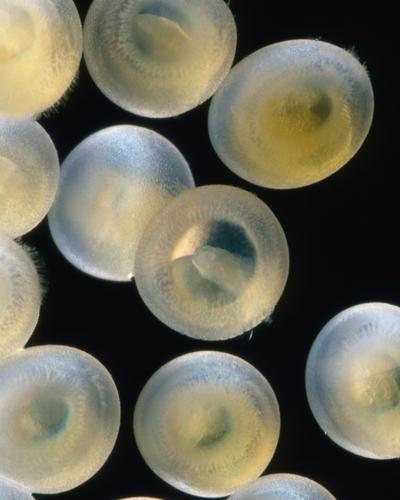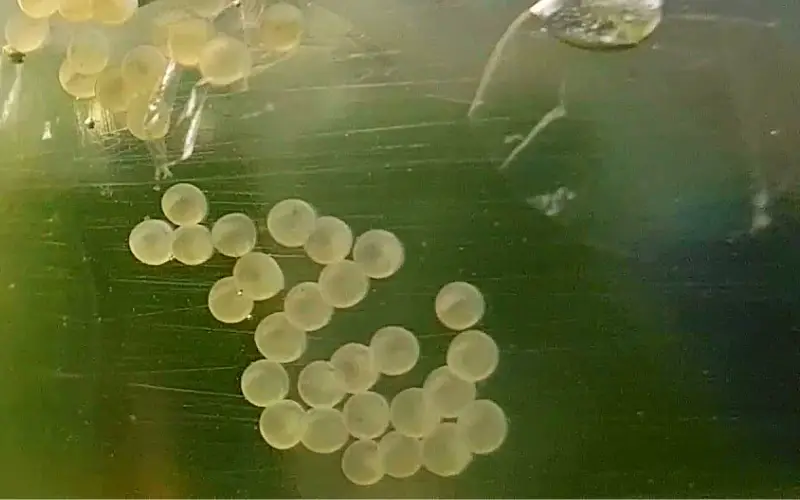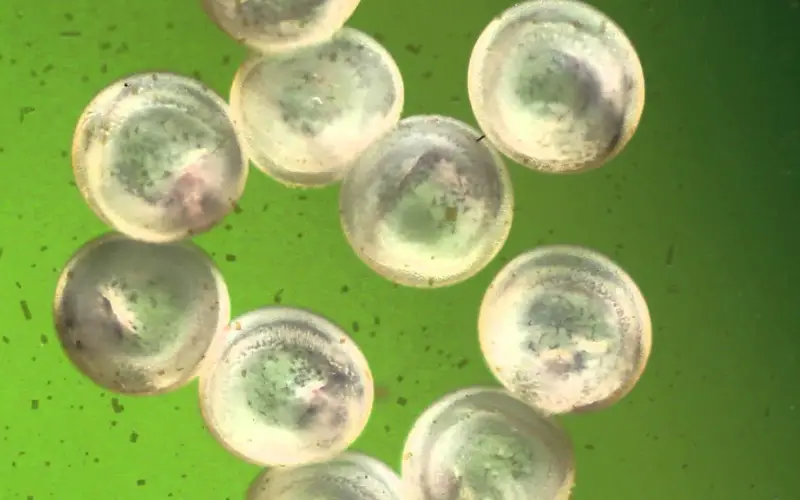What do fertilized Cory catfish eggs look like? If you’re a fishkeeping enthusiast, watching your Cory catfish lay eggs can be an exciting moment. However, the next step is equally important— What do corydora eggs look like, AND, how to tell if Cory catfish eggs are fertilized.
Knowing whether your eggs are viable ensures you can provide the right care for them and increase the chances of successfully hatching healthy fry. Fertilized corydora eggs bring the promise of new life, while unfertilized Cory catfish eggs may not develop and can negatively impact the tank environment. So, how can you identify fertilized corydora eggs?
How to tell if Cory eggs are fertile? To determine if Cory catfish eggs fertilized, observe them closely. Fertilized Cory catfish eggs typically have a small, dark spot inside, which signifies the developing embryo.
On the other hand, if the eggs remain clear or pale and lack this dark spot, they are likely unfertilized and won’t hatch.

Monitoring these subtle unfertilized fertilized unfertilized cory catfish eggs differences is essential for successful breeding, as it helps you decide whether to continue caring for the eggs or remove them to maintain tank hygiene.
Understanding how to tell if catfish eggs are fertilized, is a key distinction will set you on the right path to becoming a pro at Cory catfish breeding. Read on for more tips and insights to help your fishkeeping journey thrive!
Table of Contents
ToggleWhen do Corydoras Start Laying Eggs?
Corydoras reaches sexual maturity age from 6 to 9 months of age. Afterward, your Corydora will start mating if they meet the right conditions.
When the mating process is successful, the female will soon begin laying eggs, particularly considering that they can lay several batches in the same tank alone. How to tell if the eggs are fertilized?

First, you need to identify the female Corydoras from the male. Usually, males will have more extensive and longer fins than females. Additionally, female fish tend to look bulkier due to their egg-filled abdomens.
Once you’ve identified your fish as a female, the next step is to look for fertility signs. The most obvious sign of fertilized Cory eggs is a small white dot inside the egg at its center – if you see this, your Corydoras eggs have likely been fertilized.
How Cory Catfish Egg Development Happens – A Must-See!
Fertilized Cory catfish egg development is a fascinating journey that every aquarist should understand. In this video, we dive into the secrets behind the development of Cory catfish eggs, from fertilization to hatching.
You’ll learn about the ideal conditions for egg survival, tips for protecting the Cory fish eggs from predators, and how to care for the fry after hatching. Watch as we capture mesmerizing time-lapse footage of the entire process, bringing you closer to nature’s wonders.
Whether you’re a beginner or an experienced fish keeper, this video is packed with insights to help you succeed in raising healthy Cory catfish. Subscribe for more fish-keeping tips and updates!
How Many Eggs do Corydoras Lay?
How many eggs do Cory catfish lay? Corydoras lay 50 or more eggs simultaneously, but the number can vary considerably. Corydoras genus varies in age, food consumption, environment, and other characteristics.
Catfish have bigger eggs: some Cory catfish lay their eggs to hatch them in small containers or batches while others spread them. In many cases, they can lay up to 200 eggs at once.
The size of the eggs is also an essential factor. Corydoras species have different sizes, and some are bigger than others.
What Do Cory Catfish Eggs Look Like?
What do catfish eggs look like? When there are many fish intermingled, a lot of times, the question of whose egg is which is elusive. Unless you breed fish, you should separate them to eliminate bacteria and keep them away.
What do Cory eggs look like? Sometimes Corydora’s egg is tricky to find. This tank does, but not all eggs will appear spectacular or incredibly beautiful. The other thing to remember when looking for fish eggs is that you can generally see 10-50 eggs at a time.
This number helps people find these numbers quickly, but there’s a good chance you can. These eggs are spreading in such a way to protect them.
Do Cory Catfish Lay Unfertilized Eggs?
Cory catfish lay eggs unfertile. It is a common occurrence if Cory catfish is introduced to community tanks. An unfertilized egg is characterized by its tendency to lay a teardrop-shaped egg on top of an empty tank. The female lays these infertile eggs in various ways.
The unfertilized Cory catfish eggs do not have any development and can be identified by their clear, yellowish hue. They typically look slightly shrunken compared to fertilized Cory eggs.
How to Tell If Cory Catfish Eggs Are Fertilized?
How to tell if corydora eggs are fertilized? Examining it closely is the best way to tell if a Cory Catfish egg is fertilized. If you see a small black dot in the egg’s center, chances are your eggs have been successfully fertilized!

You can also look for increased activity within the tank – female Corydoras tend to be more active when Cory eggs fertilized.
In addition, you can observe the behavior of the fish for signs that mating has taken place – female Corydoras may become more aggressive to protect her eggs, and males may exhibit more territorial behavior as well.
What Do Fertilize Corydora Eggs Look Like?
What do fertile Corydoras eggs look like? Fertilized adult Corydoras eggs are usually larger and clearer than unfertilized eggs. They may also turn brownish and have a white dot in the center, indicating that the Cory eggs fertilized.
Once you have identified fertile Cory eggs, move them as quickly as possible to another tank with water of the same temperature and pH as the original tank to ensure proper care.
This can help to increase the chances of survival for the fertile corydora eggs and, ultimately, successful Cory catfish eggs hatching time.
By following these tips, you can increase your chances of breeding Cory catfish successfully. Raising Cory Catfish – Happy breeding cory catfish!
How Do Cory Catfish Eggs Get Fertilized?
How do Corydoras fertilize their eggs? During the whole breeding or Corydoras process, male and female Cory Catfish will release their gametes (sperm and eggs) into the water.
When these gametes meet, they will form a fertilized egg. The sperm cell will attach itself to the egg cell and begin to develop, eventually hatching into a fully grown Cory Catfish.
This entire process typically happens within a few days after mating and is essential to Cory Catfish reproduction.
How Long Does It Take Cory Cat Eggs to Hatch?
how long do Cory eggs take to hatch? Depending on the species of Cory Catfish, eggs can take anywhere from two to fourteen days to hatch.
In general, it’s best to keep a close eye Cory catfish egg development so that you can intervene if necessary and provide any additional care or resources needed.
Also, make sure to maintain the water temperature and pH levels, as this can significantly affect the rate of hatching.
Once the eggs are hatched, providing plenty of food for the baby fish to develop correctly is essential.
With proper care, start feeding, and maintenance, Cory Catfish can live long and healthy lives in captivity – providing you with lots of love and entertainment!
How to Care for Newly Hatched Cory Catfish?
Once your fry has hatched, the next step is providing proper care. Firstly, keeping the water parameters for fry at the proper levels is essential – a temperature of around 72°F and a pH of 6.5-7.0 is ideal for the fry to thrive.
It is also essential to feed them a diet rich in protein and vitamins so that they can grow healthy and strong. You can provide them with live foods such as newly hatched brine shrimp, blood worms, or daphnia, or you can use a high-quality commercial food for Cory Catfish fry.
Finally, providing your fry with plenty of clean water and performing regular partial water changes to keep the aquarium environment healthy is essential.
Following these tips ensures that your Corydoras catfish eggs hatch successfully and that your fry receives the best possible care. Good luck!
Why Are My Cory Eggs Not Fertilized?
If you’re attempting to breed Cory Catfish, one of the most common reasons your eggs may not be fertilized is that you don’t have a male fish in your aquarium.
Cory Cats are egg-scattering species and require the presence of both female and male members of their species to produce offspring.
If only females are present, they won’t be able to reproduce, so you must provide them with a male counterpart if you want successful fertilization.
What to Do After a Cory Has Laid Her Eggs?
Cory catfish lay eggs that can be found in aquariums but are rarely seen by anyone. However, if you notice rotten eggs, it is hardly a problem for an aquarium hobbyist.
If a female Cory Catfish was introduced to a community aquarium in association with a male of the same breed, she usually laid eggs. If you discover that your Cory Catfish laid eggs, a few things should be done to ensure the best chance of successful hatching.
Firstly, removing any other fish in the community breeding tank is essential, as Corydoras eat the eggs or harm them in some way. Secondly, it is also necessary to maintain good water quality by performing regular partial water changes and keeping the temperature and pH levels in check.
Finally, it would help if you fed the fry a nutritious diet once they have hatched to ensure they grow healthy and strong. Following these tips can help your Cory Catfish eggs to hatch successfully!
– Observe the Eggs for a Few Days
Check eggs for changes in color over the next couple of days. When an egg matures, you can determine if it is fertile.
Unless the eggs appear to be contaminated with water or have an excessive moisture content, there can always be a problem with your main tank water system’s quality. Occasionally a water leak may be triggered in the main tank water.
If the egg turns from clear to pink and appears more significant, it is likely a healthy, viable embryo. If the eggs remain white and unchanged after five days, they are probably unfertilized and should be removed.
Monitor your Corydoras Catfish eggs for at least a few days before taking any action. This will enable you to observe any changes and determine whether the eggs are alive.
– Separate the Eggs from The Females
Have you heard of female fish eating Corydoras eggs? The best way to prevent this is to observe the reproduction process closely to avoid it. Check eggs closely in female tanks.
These will be placed on any solid surface in the tank, including rocks or other materials. Immediately take away the eggs. Please be gentle when handling the eggs. They’re delicate and easily damaged.
– Manage the Egg Environment
If you move the eggs into separate tanks, keep the water hot. Keep in mind the temperature should be between 60 and 76 degrees. Warm temperatures will encourage Corydoras eggs hatching time faster and a better chance of surviving in a separate container for the eggs.
Another thing that can be useful in environmental conditions is to keep a lid on the tank. This will prevent debris or water from entering the aquarium and posing a risk to the eggs.
Finally, reduce light levels in the tank since direct sunlight may harm these sensitive eggs. A dim light bulb can provide enough illumination to view them without damaging them.
By ensuring the right conditions, you can guarantee the successful hatching of Cory Catfish eggs.
Patience is vital when it comes to Cory Catfish reproduction. Eggs should hatch within 10-14 days, depending on the temperature of the water.
Temperature as Variable
Temperatures are an essential factor for your Corydora egg production. The cooler the waters, the higher temperatures and the earlier the eggs can hatch. The animal metabolism in hot water will also increase, influencing the rate at which the egg-laying process begins.
Statistical studies on henna hatch rates (snakeheads) showed the faster the egg lays, the higher the temperature. Eggs hatched at 89-95°C most rapidly. But fewer fry survives in these extreme temperatures. The eggs started hatching quickly, and a good amount survived. It looks like a nice place.
Remove Unfertilized Eggs
Unfertilized eggs contain bacteria that need removal to prevent their growth. The bacteria can spread through fertilizing egg cultures, ruining it all.
Sometimes, it takes a week to turn the fertilized egg brownish or has black streaking over its surface. All other eggs that are not fertilized are still white, while the bacteria that have been developed are white.
When some eggs start turning, but others don’t, it’s the perfect moment for their separation of them. Sort them gently and remove eggs without fertilizing them to stop bacteria from spreading.
How to Adjust the Tank for Cory Catfish Eggs?
Your Cory eggs won’t stay alive if your aquarium doesn’t provide enough oxygen and water. List some essential things you have to adjust in the tank.
- Adjust water temperature, pH, and ammonia levels – Ensure the water is warm enough, clean, and oxygenated. The ideal temperature for Cory eggs is between 72-78°F (22-26°C).
- Provide plenty of hiding spots for eggs – Provide clay pots or artificial caves to shelter the eggs.
- Change the water frequently – Make frequent changes to keep water parameters in the tank clean and germ-free.
- Maintain good food – Use a high-quality filter to remove debris and ammonia from the tank.
- Put some plants in the aquarium – If you can, add some floating plants in the tank. This will help to keep the eggs safe and oxygenated.
Maintaining the perfect aquarium requires balancing oxygen levels and water flow, both essential for aquatic life. An air pump or air stone helps create this equilibrium by introducing significant levels of oxygen and providing movement within the habitat, which benefits fish health.
By ensuring your aquarium has the right conditions, you can guarantee the successful hatching of Cory eggs.
Caring for Corydoras eggs
Once the Corydoras grow, they must ensure they have eggs hatch correctly. The corydora isn’t good at raising children, but fortunately, hatching is relatively simple.
Corydoras don’t need to eat or be fed exceptional food while in the egg—they get nutrients from the egg sac. Once the fry hatch, however, you should feed them a diet of baby brine shrimp, micro worms, plant leaves, and other small foods.
If you notice that some eggs aren’t developing, remove them from the aquarium before they hatch and become a snack for the other fish.
In conclusion, to raise Cory Catfish eggs successfully, you must provide the proper environmental conditions in your community tank. Adjust the water temperature and pH level, provide plenty of hiding spots, and change the water frequently.
Additionally, remember to remove the unfertilized Cory catfish eggs, feed them the right food once they hatch, and watch for any unhealthy eggs. You can guarantee the successful hatching of Corydoras eggs with patience and care.
Conclusion
So, how to tell if Cory eggs are fertile? To summarize, there are a few surefire ways to determine if Corydoras eggs fertilized. Inspecting the females’ abdomen for tiny dark spots near the swim bladder is one tell-tale sign that the Corydora eggs fertile. Additionally, color differences in unfertilized and fertilized Cory catfish eggs can give insight into whether or not fertilization has occurred. Finally, experienced fish breeders will be able to notice physical changes in the female before any changes to the eggs take place.
In general, close observation is required to make sure Cory catfish eggs fertilized and developing correctly. Keeping an eye on the artificial habitat where they were laid is critical; making necessary alterations if external factors such as temperature, pH level, or filtration need to be adjusted to ensure successful hatching will lead to healthy catfish fry in no time!
You might also like
- How to Tell If Cory Catfish Is Pregnant? (3 Proven Symptoms)
- How to Tell If Corydoras Are Happy & why it matters?
- Pregnant Cory Catfish: The Exclusive Breeding Guide of 2023
- Cory Catfish Breeding: 7 Proven Tips for a Successful Raising
- Corydoras Catfish Eggs: A Comprehensive Beginners Guide
- Cory Catfish Male Vs Female: 99.9% Accurate Sexing Guide
- Corydoras Catfish Breeding Behavior: (3 WARNING Signs of Trouble)
- Can Corydoras Live Without Air Pump: Here’s How They Do It!




